Ever wondered why some feedback surveys give you game-changing insights, while others only generate vague or unhelpful responses?
Here’s the deal: It’s not about how many feedback survey questions you ask—it’s about asking the right ones.
A well-structured feedback survey helps businesses gather actionable insights by asking the right questions in the right format. From open-ended questions that encourage detailed responses to rating scale and multiple-choice questions that provide quantitative data, designing a survey with a mix of question types ensures comprehensive feedback collection.
This article will walk you through how to craft the best feedback survey questions to get honest, valuable, and actionable insights. Whether you’re improving customer experience, measuring satisfaction, or enhancing your products, the right survey can help you make informed decisions that lead to real growth.
Let's start with defining a feedback survey!
TL;DR
-
Customer experience is the core of the success of any business, and feedback surveys are the most effective way to measure customers' satisfaction levels with their experiences with your products and services.
-
The effectiveness of the feedback surveys depends largely on the questions you include in them and choosing the right feedback survey questions depends on the core purpose and objectives of your feedback survey.
-
Choose among the various questions for different objectives like measuring customers' overall experience, measuring product experience, measuring service experience, measuring website experience, conducting market research, and more.
-
You can use a variety of feedback survey questions like Net Promoter Score survey questions, Customer Satisfaction Score (CSAT) survey questions, and Customer Effort Score (CES) survey questions to get a quantifiable measure of customer loyalty, satisfaction and perceived efforts.
-
Zonka Feedback is an effective customer feedback software that provides you with ready-to-use customizable survey templates with various question types. You can also schedule a demo to explore more about the tool.
Build and send a survey today 🔥
Choose from over 30+ question types, add your own themes and create amazing surveys that people love answering.

What is a Feedback Survey?
A feedback survey is a structured method for collecting insights, opinions, and experiences from customers, employees, or stakeholders. It serves as a vital tool for organizations aiming to understand perceptions, measure satisfaction, and drive improvements.
At its core, a feedback survey is more than just a set of questions—it is a mechanism for continuous learning and adaptation. Whether used to gauge customer experience, employee engagement, or product usability, well-designed surveys reveal not only what people think but also why they think that way.
Organizations that embrace a structured approach to feedback collection can identify gaps, predict trends, and make data-driven decisions. They can proactively close the feedback loop, responding to concerns before they escalate and reinforcing behaviors that lead to loyalty and advocacy.
Effective feedback surveys are:
- Targeted: Aligned with specific business objectives, ensuring relevance.
- Strategic: Designed to collect actionable insights rather than just data.
- Adaptive: Leveraging modern tools to personalize, automate, and integrate feedback across channels.
Here is an example of a feedback survey.
You can use this customer satisfaction survey template to collect feedback and measure the satisfaction of your customers. You can customize this template as per your survey requirements.
Top Examples of Customer Feedback Survey Questions
-
On a scale of 1 to 5, how would you rate your overall experience with our brand?
-
How would you rate your in-store visit experience today?
-
How likely are you to recommend our brand to others on a scale of 0 to 10?
-
How likely are you to purchase from us again?
-
What do you like/dislike about our brand?
-
Please share your experience with our brand in your own words.
-
What is your biggest challenge in doing business with us?
-
How can we improve your experience with the company?
-
How would you rate your satisfaction with the product on a scale of 1 to 5?
-
What do you like or dislike the most about our product?
-
Based on your product experience, how likely are you to recommend us to others on a scale of 1 to 10?
-
What's your biggest roadblock when using our product?
-
Does the product help you achieve your goals?
-
What is your favorite tool or feature of the product or service?
-
What would you improve if you could/What is the one feature you would like to see in our product?
-
How would you describe the satisfaction with our product in your own words?
-
Please rate your satisfaction with our team in resolving your issue.
-
Did you feel that our team answered your inquiry promptly?
-
How strongly do you agree or disagree with this statement: the customer service team made it easy for me to get my issue resolved?
-
Based on your customer service experience with us, how likely are you to recommend our brand to others?
-
What can we do better to improve your customer service experience?
-
How would you rate the agent's performance on a scale of 1 to 5?
-
What did you like/dislike the most about your customer service experience with us today?
-
How would you rate our website on a scale of 1 to 5?
-
How likely are you to recommend our website to others?
-
How would you rate the shopping experience on our website on a scale of 1 to 5?
-
What did you like/dislike about our website when making a purchase?
-
Please share in your own words what was your experience like on our website.
-
We see that you didn't complete your purchase. What can we improve to help you finish shopping on our website today?
-
What made you purchase on our website today?
-
What's your most important priority when using a product like ours?
-
Why did you choose our product over a competitor's?
-
What stopped you from buying from us?
-
What is one thing you wish our product could do?
-
How did you find out about our product?
-
How disappointed would you be if you could no longer use our product/product feature?
-
Which product/service would you consider as an alternative to ours?
-
How would you rate the overall satisfaction of working with our organization on a scale of 1 to 5?
-
On a scale of 0-10, how likely are you to recommend this organization as a good place to work?
-
What do you like/dislike about this organization?
-
How would you rate the training and growth opportunities provided to employees in our organization?
-
Please share in your own words what your experience of working with this organization has been like.
These examples of feedback survey questions can be used for different survey goals. We have separated them into specific categories so you know when to use which question.
Let's understand each question in detail.
Feedback Survey Questions To Measure Customer Experience
According to PwC research, 73% of consumers are more loyal to brands that offer good customer experiences. This can include experiences related to purchase transactions, online experiences, customer service experiences, store visit experiences, etc.
To measure customer experiences, you will have to measure their satisfaction levels with each experience through the primary CX metrics like CSAT and NPS. However, you can also get insightful responses in terms of customers' experiences through closed and open-ended questions.
Let's understand how to measure customers' experiences with the top feedback survey question examples.
1. On a scale of 1 to 5, how would you rate your overall experience with our brand?
This is the primary CSAT survey question which can be used to measure customers' happiness with the brand as a whole specific products, as well as a specific experience. In this context, the feedback survey question would help in measuring customers' overall satisfaction with your brand.
You can ask the feedback survey question at fixed milestones or specific customer journey touchpoints or after customers' certain experiences with the brand.
2. How would you rate your in-store visit experience today?
This feedback question measures your customers' store or site visit experience. When measuring overall in-store experience, the customer feedback is generalized for different aspects including billing experience, facility experience, in-store staff support, etc. To collect specific feedback, you can replace the term ‘in-store visit' with the specific aspect of your store that you're looking to collect feedback on.
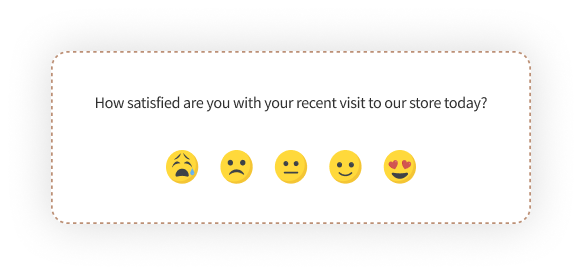
3. How likely are you to recommend our brand to others on a scale of 0 to 10?
This is a Net Promoter Score question that helps in measuring customers' loyalty to your brand. Based on your customers' likeliness of recommending your business to others, you can understand whether they would keep coming back to you or choose a competitor over you.
The answer to this question helps you in identifying Promoters, Passives, and Detractors, where Promoters (scores 9-10) are your most loyal customers, Passives (scores 7-8) may be swayed by a better offer or deal, and Detractors (score 0-6) are dissatisfied and likely to churn away.
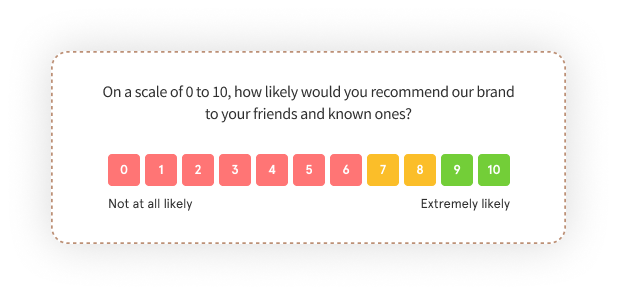
4. How likely are you to purchase from us again?
This again is a customer experience survey question that helps in understanding your customers' likeliness of doing business with you again. You can capture the answers on a 0-10 scale, where the customers who give you a low score may be retained by following up with them to resolve their challenges.
5. What do you like/dislike about our brand?
This is a close-ended customer feedback survey question to understand from customers what aspects of your business they liked or disliked. This helps you know how your brand is perceived by your customers and focus on the right things to foster customer retention. For example, if you are a SaaS product company, you can understand what customers like about you, such as customer service, innovation, product pricing, etc.
Similarly, you can give your customers multiple choices to select from to describe what they dislike about your brand like high prices, fewer updates, poor customer service, etc. This feedback survey question helps put finger on exactly what's working for you and what's not.
For instance, you can always ask this question with other health survey questions or patient feedback questions to know what the patients or their guardians feel about your healthcare facility. It can offer you insight into different aspects of your offering and help you identify pain points, issues with the care delivered, and areas where you can improve.
6. Please share your experience with our brand in your own words.
This is an open-ended question and a very important one since it allows customers to share their responses in their own words. It does not restrict customers to a set of choices and gives them a chance to vent out and share their challenges. This can help you uncover even the roadblocks you may not have been anticipating.
7. What is your biggest challenge in doing business with us?
The purpose of asking this feedback survey question is to understand the major roadblocks that may be leading to lesser conversions or purchases. The idea is to identify the factors that are obstructing brand growth and remove them to increase conversions, sales, and customer loyalty.
8. How can we improve your experience with the company?
Often, customers would refrain from complaining about an issue unless they have had an extremely terrible experience with a business. With this customer experience question, you can encourage your customers to share the challenges they experienced, no matter how small they may be.
This helps businesses align themselves completely with customers' expectations and also increases their recognition as a customer-centric brand.
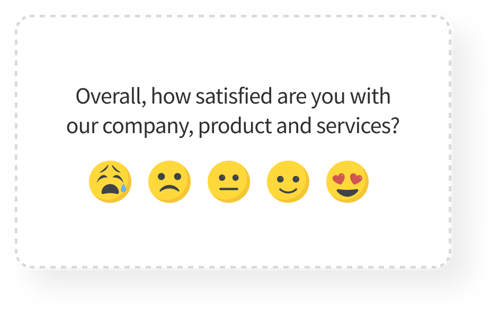
Feedback Questions To Measure Product Experience
Product feedback questions collect product-specific customer feedback on different aspects like product quality, quantity, pricing, delivery, ease of use, innovation, etc. Whether it's a physical product like an electronic device or a software tool, you can restructure these examples of customer feedback questions to collect product feedback:
9. How would you rate your satisfaction with the product?
This is a simple CSAT survey question used to measure the satisfaction of customers with the product on a rating scale. This gives you general customer feedback, i.e., the overall satisfaction score for your product. However, you cannot identify the key factors leading to this score using this question.
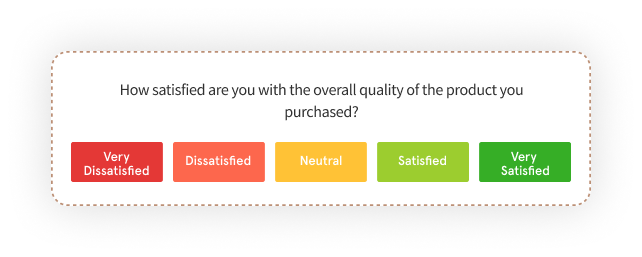
10. What do you like or dislike the most about our product?
This can be a closed-ended question with multiple choices for customers to select answers from. Based on what you have to offer, you can include choices like pricing, product quality, speed of delivery, customer service, etc. to understand exactly what it is customers like or dislike.
11. Based on your product experience, how likely are you to recommend us to others on a scale of 1 to 10?
This is a Net Promoter Score question that helps in understanding customers' loyalty towards your brand as per their satisfaction with the product. For example, if you're offering a SaaS product, you can understand whether or not your customers are loyal to you based on their satisfaction with your product.
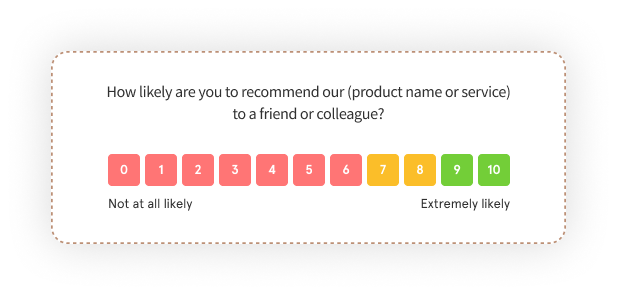 12. What's your biggest roadblock when using our product?
12. What's your biggest roadblock when using our product?
This is one of the examples of customer feedback questions when you're looking to collect product feedback. It helps in understanding the major challenges that your customers face when using your product so you can directly eliminate the issues leading to customers' dissatisfaction.
13. Does the product help you achieve your goals?
This simple customer feedback survey question helps in understanding whether or not the product is helping achieve the goals it is designed for like UI design software
14. What is your favorite tool or feature of the product or service?
This is a closed-ended question where you can give your customers multiple choices to select from. Customers can share what they like the most about your product so you can improve it further and market it further to increase leads and conversions.
15. What would you improve if you could/What is the one feature you would like to see in our product?
This question helps in capturing innovation-specific customers' opinions since it helps in understanding what is it that customers feel is missing from your product. With feedback on what customers would like to see or use in your product, you can make way for innovation.
16. How would you describe the satisfaction with our product in your own words?
This is one of the most important examples customer feedback questions for product-specific data since it makes way for unsolicited feedback and may even help you capture feedback data that you may not have anticipated. By identifying common keywords in customers' responses, you can understand what customers feel about your product.
This is a must-have feedback survey question when you're asking product-specific CSAT (customer satisfaction)and NPS questions since it helps in backing up the scores given by customers with relevant feedback and makes the whole feedback super insightful.
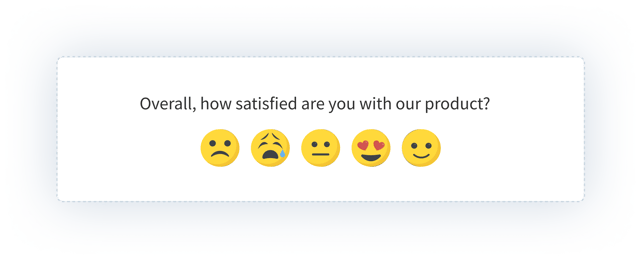
Feedback Survey Questions To Measure Customer Service Experience
Customer service feedback survey questions help in measuring and understanding customers' efforts in seeking support from your brand when doing business with you. There are different customer feedback questions that can help you capture customer service feedback as a whole as well as agent performance feedback.
Let's read about some examples of customer feedback questions for customer service feedback.
17. Please rate your satisfaction with our team in resolving your issue.
This is a simple CSAT question that helps in measuring your customers' satisfaction with the support they receive. This question should be a part of your customer service survey to capture general customer feedback in terms of the customer service as a whole, and can be coupled with other closed-ended or open-ended customer feedback questions to collect quantitative customer feedback.

18. Did you feel that our team answered your inquiry promptly?
This can be a simple Yes/No or Dichotomous question that helps in understanding whether or not the customer received the support they were expecting. This question, however, does not offer qualitative feedback, and hence, must be avoided alone. You can always follow it up with an open-ended question to understand what went wrong or what worked for your customers.
You can read our article on Why to Avoid Dichotomous Questions. This article highlights where and where not to use such Yes/No customer feedback questions.
19. How strongly do you agree or disagree with this statement: the customer service team made it easy for me to get my issue resolved?
This is the primary CES (Customer Effort Score) survey question which helps in measuring customers' efforts in getting their issues resolved. For example, if a customer reaches out to seek service from your support team, this question can be asked after they are helped to be able to understand if the support team was efficient in helping the customer.
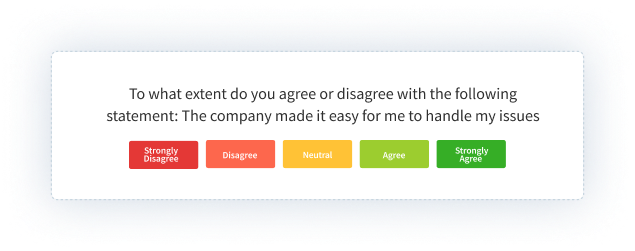 20. Based on your customer service experience with us, how likely are you to recommend our brand to others?
20. Based on your customer service experience with us, how likely are you to recommend our brand to others?
One of the most used NPS feedback survey questions, helps frontline teams understand their customers' likeliness of speaking positively about their brand and finding how many loyal customers you have with your business. This helps in measuring customers' loyalty based on their service support experience with your brand.
21. What can we do better to improve your customer service experience?
This can be an open-ended question to let customers share in their own words what can be improved so that they are more satisfied with the support received. This helps in directly working on issues that are leading to an increased customer service effort.
22. How would you rate the agent's performance on a scale of 1 to 5?
This is a direct CSAT (customer satisfaction) survey question used to measure agent performance. This can be sent to collect customer feedback after every customer service interaction and helps in internal performance reviews. You can identify agents that are doing well and agents that need more training or help in assisting customers in a better way, which can improve the overall customer service and increase the number of satisfied customers.
23. What did you like/dislike the most about your customer service experience with us today?
This can be a closed-ended question with multiple choices that customers can select from to describe their service experience. In the answer choices, you can include aspects such as speed of resolution, efficiency, communication, knowledge, etc.
Feedback Survey Questions To Measure Website Experience
A website experience survey question helps in collecting customer feedback about your website on different aspects like order placement, payment, website UI/UX, speed, content, etc.
Let's read in detail about some examples of customer feedback questions.
24. How would you rate our website?
This simple satisfaction feedback question with emoji surveys or 1 to 5 rating scale can be used to measure your customers' overall satisfaction with the website. This helps in capturing general customer feedback without harping on details to understand how your website is performing.
25. How likely are you to recommend our website to others?
This NPS survey question helps in measuring customers' loyalty to your brand based on the website experience you offer. This is important since many customers may not come forward to share minor challenges, but may share their honest views when asked if they would recommend the website.
26. How would you rate the shopping experience on our website on a scale of 1 to 5?
This is one of the critical examples of website feedback form questions when you're looking to collect eCommerce website feedback. It helps in measuring customers' overall satisfaction when making a purchase on your website. The satisfaction score may be based on various factors like product availability, payment modes, speed, pricing, etc. To understand the reason for the satisfaction score, you can follow up this question in website surveys with a closed or open-ended question to get descriptive feedback.
27. What did you like/dislike about our website when making a purchase?
This can be a closed-ended question with multiple choices so customers can share customer feedback on exactly what they liked or disliked on your website. You can include options like speed, product availability, pricing, digital content, navigation, UI, etc.
28. Please share in your own words what your experience was like on our website.
This feedback survey question helps in capturing unanticipated feedback on the website since customers aren't limited by a list of options to choose from. With this website survey, customers can share exactly how they feel shopping on your website so you can understand what works and what does not.
29. We see that you didn't complete your purchase. What can we improve to help you finish shopping on our website today?
This is a website exit intent survey question that is triggered especially for visitors who tend to leave the website without making a purchase. You can either give multiple choices so customers can select what stopped them from shopping or ask an open-ended question so customers can share in their own words what they would like to see on your website to be encouraged to shop from you.
30. What made you purchase on our website today?
This question is asked specifically to visitors who complete their purchase on your website. It helps in understanding what's leading to sales/conversions so you can capitalize on the factors shared by your customers and increase sales. You can also match the data to check was it a one-time or repeat purchase, based on which you can tailor and customise your offers and discounts.
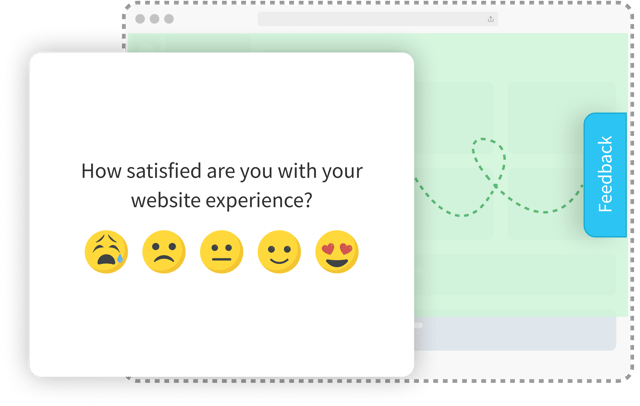
Feedback Survey Questions To Conduct Market Research
Market research feedback survey questions help in capturing customer data in terms of market demand and factors leading to that demand. Whether you're a retail brand or offer your product or services online, you can modify the market research survey questionnaire to understand what it is that makes a brand desirable.
Let's read through some examples of customer feedback questions for market research in detail.
31. What's your most important priority when using a product like ours?
This is a closed-ended market research survey question where you can list down all the factors that customers can choose from to describe what it is that drives them to use a product like yours. For example, if you're a SaaS product company and your customers share that source innovation matters to them the most, you can increase your efforts towards new product updates every once in a while.
32. Why did you choose our product over a competitor's?
This question helps in understanding what makes your product unique and more desirable compared to your competitors' products. You can identify factors like pricing, innovation, variety, website experience, customer service, etc., and capitalize on the leading aspects to increase conversions. You can also use the feedback received to improve your marketing efforts and be able to get the attention of similar customers.
33. What stopped you from buying from us?
This is a question that can be triggered for website visitors who browsed through the website but didn't make a purchase. It can also be sent out to leads that didn't convert. The purpose of asking this question is to understand what discourages customers from making a purchase. As a result, brands can understand clearly what's not working and then improve it to drive sales or conversions.
34. What is one thing you wish our product could do?
This question is a must-have since it allows an understanding of what customers tend to look for in your product. As a result, you can drive innovation in the correct direction and increase the conversion rate or the chances of customers making a purchase.
35. How did you find out about our product?
This is one of the examples of feedback survey questions that help in understanding how customers come to your website or find your brand/product. With the feedback received, you can identify the channels that drive customers to your product. For example, if you know that most of your customers come in through referrals, you can improve your referral marketing efforts and increase the number of leads/conversions/sales.
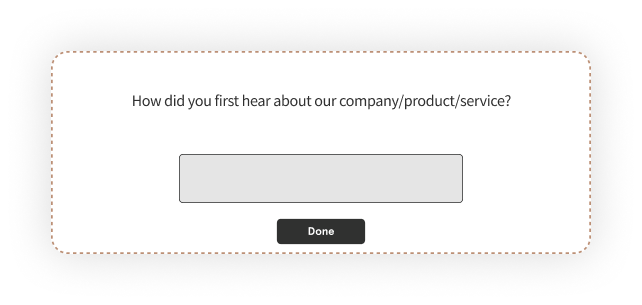
36. How disappointed would you be if you could no longer use our product/product feature?
This feedback question helps in understanding the importance of your product for your customers. It captures feedback to help brands understand where they stand and identify customers who may be likely to churn away. As a result, they can follow up with them and learn what can be done to retain them.
37. Which product/service would you consider as an alternative to ours?
This is one of the examples of customer feedback survey questions that helps you identify your major competitors and compare your product to theirs. As a result, you can identify the aspects missing in your brand and work on them so you can stay competitive and a top choice of your target audience or customers.
Feedback Form Questions To Measure Employee Experience
It is correctly said that to keep your customers happy, you must first keep your employees happy. Therefore, to measure employee experience, you can check out these employee experience-specific examples of feedback survey questions:
38. How would you rate the overall satisfaction of working with our organization on a scale of 1 to 5?
This is a general CSAT question used to measure the overall customer satisfaction score of employees for the company. The CSAT score is critical in representing employee satisfaction and creating the employee satisfaction strategy.
You can also use this employee satisfaction question to measure satisfaction based on various specific aspects like teamwork, compensation, work-life balance, growth opportunities, etc. All you need to do is modify the question to get specific feedback.
39. On a scale of 0-10, how likely are you to recommend this organization as a good place to work?
This is an NPS question used to accurately measure your employees' loyalty to the organization. The feedback can be critical in identifying employees that may require retaining. Similarly, it can also drive the employee referral program.
40. What do you like/dislike about this organization?
This can be one of the closed-ended feedback survey questions with multiple choices for your employees to select their answers from. You can list down various aspects of your organization, such as work culture, infrastructure, compensation, management, etc. to learn what your employees like or dislike.
41. How would you rate the training and growth opportunities provided to employees in our organization?
You can use a 1 to 5 rating scale or an emoji or star scale to understand from your employees how satisfied they are with the growth opportunities provided to them. You can follow this question up with an open-ended question to let employees share in their own words what they expect from the organization in terms of growth and development.
42. Please share in your own words what your experience of working with this organization has been like.
Closed-ended customer feedback questions restrict the employees to just a few aspects of your organization. However, an open-ended question makes employees feel heard since they can share feedback in their own words. Moreover, this question helps you capture unanticipated feedback in terms of employee satisfaction.
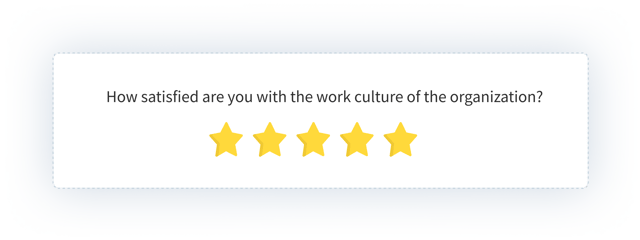
How to Frame Survey Questions for Maximum Response Quality
Most businesses focus on what to ask but overlook how to ask it—and that can make all the difference. The way feedback survey questions are framed directly impacts response rates, engagement, and the quality of insights collected. A poorly worded question can confuse respondents, introduce bias, or lead to incomplete answers, ultimately skewing the data.
To get accurate, honest, and actionable feedback, businesses need to craft survey questions strategically. Here’s how to frame them for maximum response quality:
1. Use Conversational Language
A formal, robotic question can make the survey feel impersonal. Instead of:
❌ "Rate your satisfaction with our service."
Try:
✅ "How happy are you with our service today?"
This makes the question feel natural and engaging, encouraging more genuine responses. A conversational tone makes the respondent feel like they’re having a real interaction rather than filling out a form.
2. Make Surveys Feel Effortless
The easier it is to answer, the better your response rate. Reduce friction by:
- Using progress bars to show how many questions are left.
- Keeping surveys short (under 5 minutes) unless it's a deep-dive study.
- Offering an exit option so respondents aren’t forced to answer every question.
3. Use Conditional Logic for Relevance
A common mistake is asking every respondent the same set of questions, even when some are irrelevant based on prior answers. This makes surveys feel long and repetitive.
Instead, use conditional logic (also called survey branching) to create a personalized experience:
- If a respondent rates customer support poorly, follow up with: "What could we do to improve your experience?"
- If a customer gives a 5-star rating, follow up with: "What did you love most about your experience?"
By tailoring follow-up questions based on previous answers, you keep the survey concise, relevant, and engaging, leading to higher completion rates.
4. Optimize for Mobile
With most surveys being taken on mobile devices, formatting matters. A desktop-optimized survey with tiny checkboxes and long dropdown lists can be frustrating on a phone.
To improve the mobile survey experience:
- Keep questions short and direct to fit small screens.
- Use tap-friendly options like buttons, sliders, and star ratings instead of long dropdowns.
- Ensure the survey layout is responsive, so it adjusts seamlessly across devices.
5. Use Open-Ended Questions for Deeper Insights
While rating scales and multiple-choice questions help quantify feedback, open-ended questions provide richer, more detailed insights. They allow respondents to express thoughts in their own words, uncovering insights that structured responses might miss.
Here’s how to use them effectively:
- Place them strategically—don’t overwhelm users with too many.
- Keep them concise—e.g., "What’s one thing we could improve?" instead of "Can you describe in detail your thoughts on our service?"
- Follow up on negative ratings—e.g., "What could we have done better?"
💡 Pro Tip: AI-powered feedback tool can take open-ended responses to the next level with sentiment analysis, keyword extraction, and automatic categorization. This helps businesses identify trends, emotions, and urgent issues in real-time, making qualitative feedback much more actionable.
6. Personalize the Survey Experience
Context matters. Generic surveys get ignored. Personalization makes surveys feel relevant and increases engagement.
- Use the respondent’s name and context: “Hey [Name], we’d love your quick feedback on your recent order.”
- Mention specific interactions: “How was your experience with [Agent’s Name] today?”
- Use dynamic fields (like purchase history) to tailor questions.
Example: Instead of a generic “How was your experience?” ask:
“How was your check-in experience at [Hotel Name] yesterday?”
7. Use One-Click or Embedded Surveys
The fewer clicks, the better.
Surveys that require respondents to click a link and open a new page see lower response rates.
- Use embedded survey questions in emails (e.g., “Rate your experience” with clickable options).
- Allow one-click responses (e.g., thumbs-up/thumbs-down buttons).
- Offer quick polls instead of full-length surveys for post-interaction feedback.
💡 Pro Tip: Instead of a link-based survey, embed the first question directly in the email:
“How likely are you to recommend us?” (Clickable scale from 1-10).
How to Create Feedback Surveys?
The questions mentioned above will help you create surveys effectively, but creating effective feedback surveys in not only confined to only creating questions. You should follow a proper strategy to create and leverage your feedback surveys to collect actionable feedback and improve customer experience.
What is a Feedback Survey Strategy?
A Feedback survey strategy is a system designed to collect and analyze customer feedback to produce insights required to improve customer experience. It helps businesses to overcome customer-facing challenges by making data-driven decisions in terms of products, services, customer interactions, etc. A feedback strategy is executed in four phases:
- Ask: Ask customers for their feedback on experiences with your brand
- Categorize: Analyze feedback to generate insights in terms of what’s working well for the brand and what needs to improve using creative programmatic approaches.
- Act: Use insights generated in the second phase to respond to customer feedback and resolve reported challenges
- Follow-Up: Let customers know how their feedback was used to improve their experience
Feedback survey strategy is important to:
- To listen to the voice of the customers.
- To convey the customers that you care about them and their feedback matters to you.
- To understand how well your product or service is performing
- To measure your service standards and track support agenets' performances.
- To ensure continuous improvement.
- To align your brand with customers' preferences.
- To encourage repeat purchases and earn customer loyalty.
- To identify miffed customers and take actions to improve their experiences and foster customer retention.
- To make better business decisions.
Creating a Feedback Survey
When you work on customer feedback strategy, you follow the following steps to create effective feedback surveys.
1. Identify the Survey Objectives
For creating effective feedback surveys, ensure that you have clear objectives and key results in mind about what you want to achieve through these surveys. For example, some brands may want to capture the overall satisfaction score of customers for the brand. Similarly, another brand may want to identify specifically the customers who are likely to churn.
To make it simpler, you can measure customer feedback across the three primary metrics:
- Net Promoter Score (NPS): To measure customer loyalty based on their likeliness to recommend your brand to others
- Customer Satisfaction Score (CSAT): To measure the satisfaction or happiness levels of customers with the brand or a specific transaction
- Customer Effort Score (CES): To measure customers’ efforts in doing business with you or getting an issue resolved
2. Choose a powerful survey software
A good survey software helps you create effective surveys to fetch actionable information from your customers about their needs and preferences, and their perceptions about your products, services, and brand. An effective survey software is well equipped with powerful features like:
- Ready-to-use survey templates
- Multi-channel feedback collection
- Skip logic and question branching
- Ability to embed your surveys (on website, emails, etc.)
- Ability to measure customer satisfaction metrics like CSAT, NPS, and CES
- Real-time feedback alerts and notifications
- Closing the feedback loop
3. Design your Survey Questionnaire and make it Engaging
The next step is to design your questionnaire by crafting the relevant questions as per your survey objectives. You can choose from the above questions as mentioned with the respective objectives of your survey. To make your surveys engaging,
- use features like skip logic and question branching and make your surveys dynamic for the respondents thereby providing them personalized survey experiences.
- Brand your surveys by whitelabelling your surveys and adding your own brand logo, color, and styling to the survey.
- Use simple questions with easy language to avoid survey abandonment and inaccurate survey responses.
3. Survey customers at the right touchpoints across preferred channels
Once you’re done creating your customer feedback surveys, the next step is to send them to your customers at the right time. You have to ensure that you are asking the right feedback survey questions to your customer at the right time and right place. For this, you will have to identify touchpoints that matter. Here are some examples of feedback survey touchpoints:
- Post-Transaction: To measure satisfaction right after a transaction, for example, a purchase, subscription, or renewal.
- After Customer Service Support: To measure customers’ effort in getting an issue resolved and to measure agents’ performances while offering support
- App Transaction Feedback: To collect in-app user feedback in terms of app quality, user interface, speed, accuracy, and content.
- Website Feedback: To collect feedback on various aspects of your website as well on certain user behavior, for example, exiting the website without a transaction, or abandoning a cart.
Once you identify all the touchpoints where you wish to send out surveys, make sure to also define channels where your survey audience is more likely to engage with surveys. Trigger surveys at relevant channels, like website surveys to collect website feedback, in-app surveys for your app users just after a transaction, email surveys or SMS surveys after a customer interaction via email or phone call.
You can also find out the mode of communication that your customers prefer and then send surveys through those specific modes.
Ask the Right Feedback Survey Questions with Zonka Feedback
Customer feedback surveys are a great way to measure customer satisfaction and gauge the overall experience of your customers. To create effective feedback surveys, it is crucial to include the right customer feedback questions in them.
Creating a feedback survey, irrespective of your feedback goals, is fairly easy since most survey tools today are code-free. And if you're wondering where to start, readymade feedback survey templates can be helpful.
With an effective survey tool like Zonka Feedback, you get access to free survey templates for different industries including retail, eCommerce, hospitality, education, etc. as well as for different feedback goals.
You can also schedule a demo to explore more about the tool.
.jpg)

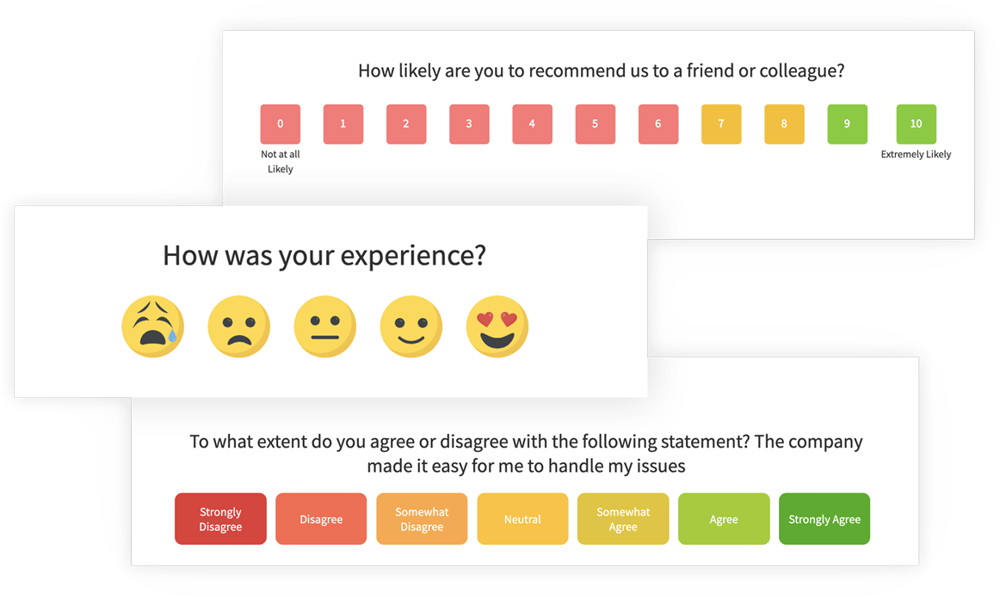



.png)


.jpg)
.jpg)
.jpg)

.jpg)